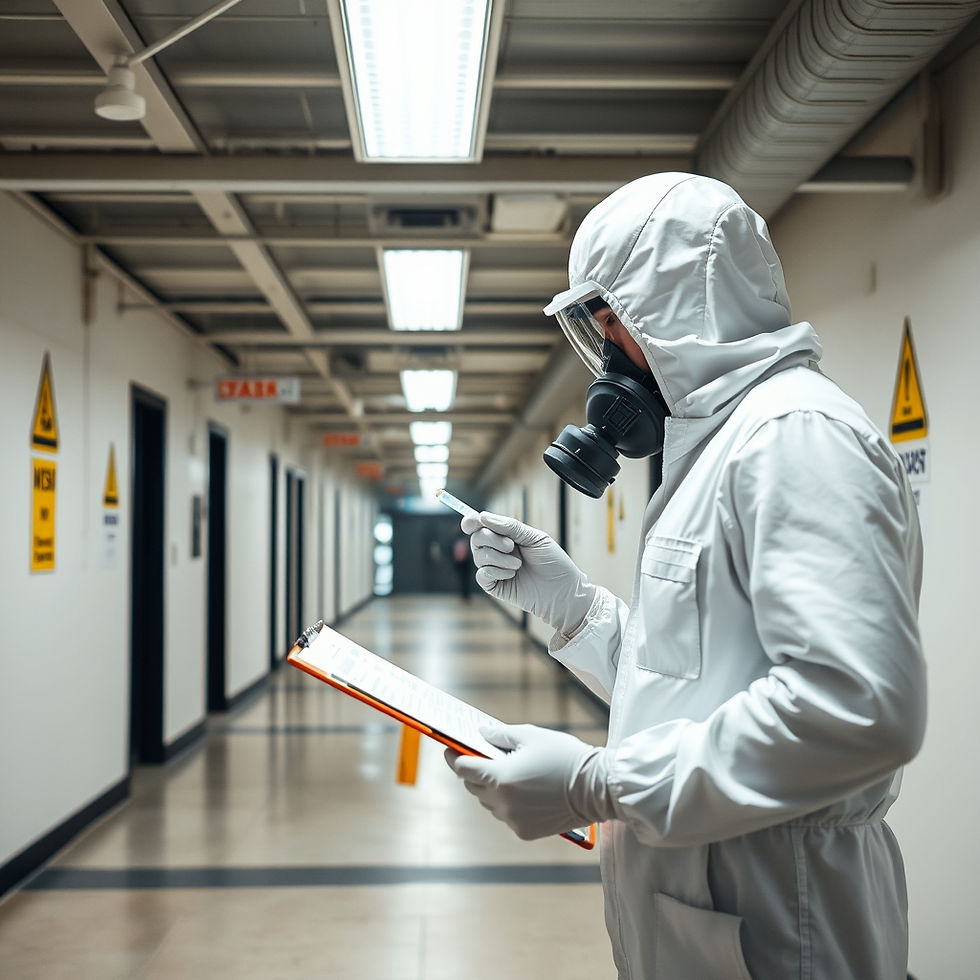The Importance of Asbestos Testing in Commercial Buildings
- John Mayers
- Jun 2
- 3 min read
Asbestos, once hailed for its insulation and fire-resistant properties, is now recognised as a major health hazard. Despite being banned in the UK in 1999, asbestos remains present in many commercial buildings constructed before this date. Understanding the critical role of asbestos testing, asbestos surveys, and asbestos removal is essential for protecting public health, meeting legal obligations, and avoiding costly liabilities.
What is Asbestos and Why is it Dangerous?
Asbestos is a naturally occurring mineral made up of microscopic fibres. When disturbed, these fibres can become airborne and, if inhaled, may cause serious illnesses such as:
Mesothelioma
Asbestosis
Lung cancer
Pleural thickening
The danger lies in the fact that asbestos-related illnesses can take decades to develop, meaning current exposure risks have long-term consequences. This is especially concerning in commercial buildings, where high occupancy and maintenance work can increase the likelihood of disturbance.
Legal Responsibilities for Commercial Property Owners
In the UK, there are strict regulations surrounding asbestos in non-domestic premises. Under the Control of Asbestos Regulations 2012, duty holders (typically landlords, managing agents or building owners) must:
Identify the presence and condition of asbestos-containing materials (ACMs)
Assess the risk of exposure
Take appropriate action to manage and monitor the materials
Ensure staff and contractors are informed and trained
Failure to carry out a proper asbestos survey and implement management plans can result in severe legal and financial penalties — not to mention health consequences.
The Role of Asbestos Testing
Asbestos testing is a process that identifies whether a material contains asbestos fibres. This usually involves collecting samples and analysing them in accredited laboratories. Testing is the first step toward safe asbestos management and offers several crucial benefits:
1. Health & Safety Compliance
Testing ensures you're compliant with the law, providing peace of mind to building occupants and stakeholders.
2. Risk Assessment
Results from asbestos testing help prioritise materials based on their risk level, guiding further action or removal.
3. Renovation and Demolition Planning
Before any refurbishment or demolition project, asbestos testing is legally required to avoid accidental disturbance of ACMs.
4. Financial Planning
Early identification can prevent unexpected costs by enabling planned, rather than reactive, asbestos removal.

What is an Asbestos Survey?
An asbestos survey is a detailed inspection carried out to locate and assess the condition of ACMs within a building. There are two primary types:
Management Survey
A standard survey designed for buildings in use. It aims to identify ACMs that could be disturbed during routine activities and maintenance.
Refurbishment and Demolition Survey
This is a more intrusive survey required before any refurbishment or demolition work. It ensures that workers and occupants are not exposed during structural changes.
The survey results will guide whether asbestos removal is necessary or if the material can be managed safely in place.
When is Asbestos Removal Necessary?
Asbestos removal is not always required — in some cases, ACMs in good condition and unlikely to be disturbed can be managed through regular monitoring. However, removal becomes essential when:
Materials are damaged or deteriorating
There’s a risk of exposure during building work
The ACMs are in high-traffic or vulnerable areas
Only licensed asbestos removal contractors should perform this work to ensure safety and legal compliance.
Choosing a Qualified Asbestos Professional
It’s crucial to hire qualified and certified professionals for asbestos surveys, testing, and removal. Look for companies accredited by bodies such as:
UKAS (United Kingdom Accreditation Service)
HSE (Health and Safety Executive) licensed contractors
Experienced professionals ensure that the work is done according to the latest regulations and industry best practices.
Consequences of Ignoring Asbestos Risks
Neglecting to carry out asbestos testing or a thorough asbestos survey can lead to:
Heavy fines and legal prosecution
Harm to employees, clients, or tenants
Project delays due to unforeseen asbestos discoveries
Reputational damage to your business or organisation
Proactive management demonstrates a responsible approach to health and safety, reducing risk and promoting trust.
Final Thoughts
The presence of asbestos in commercial buildings poses a serious risk, but it's a risk that can be managed. By investing in proper asbestos testing, conducting thorough asbestos surveys, and carrying out asbestos removal where necessary, building owners and managers can safeguard health, stay compliant, and protect their assets.
Don’t wait for a problem to arise — schedule an asbestos survey today and take the first step toward a safer, regulation-compliant workplace.



コメント